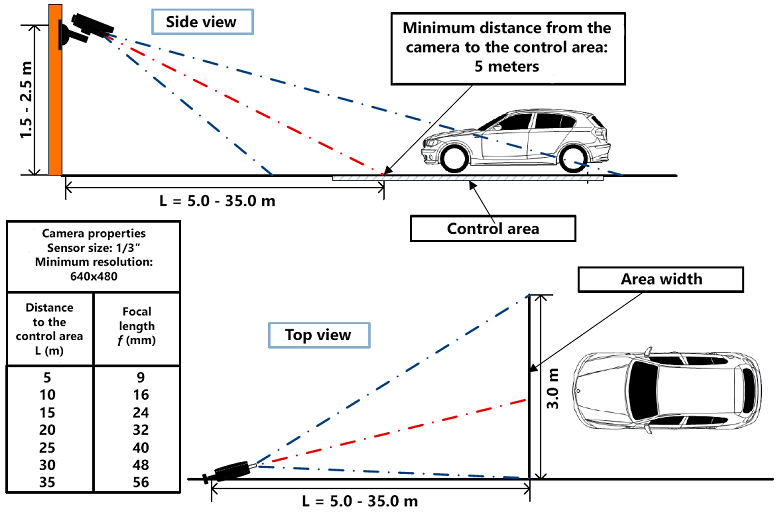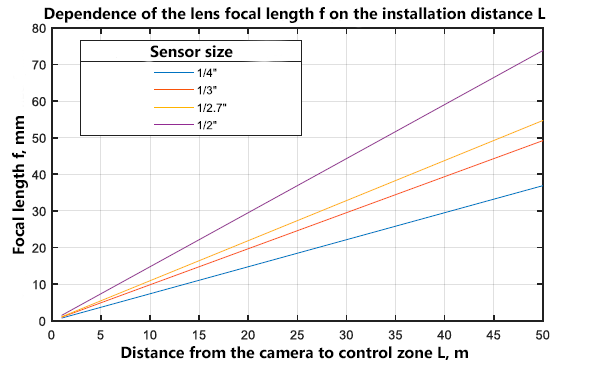Requirements and recommendations🔗
Warning
The module works only with 64-bit version of Eocortex.
For correct operation of the module, it is imperative to properly choose, place and set up the camera, adjust the software motion detector and the module itself. When selecting the camera, it is necessary to take into consideration the image requirements, the controlled zone particularities, and the conditions of the installation and operation of the camera.
Requirements to the license plate image
The vehicle license plates (registration plates) to be recognized must conform to certain requirements. The License plate recognition (Light) module cannot guarantee the reliable recognition of a license plate if it is extremely dirty, low in contrast or significantly tilted or displaced. Below are the requirements to the license plates and their images (the vehicles whose license plates do not meet these requirements will not be identified).
No visible blurring of the license plate number on the image of the moving vehicle.
No sharp glare or shadows on the license plate.
The characters on the license plate must be in total accord with the applicable state standard as regards their font and size.
The license plate must meet the requirements concerning the cleanliness and legibility. All the characters shall be distinctly visible and not blocked by anything.
The images of the license plate numbers must be sharp. The contrast between the characters and the background must be at least 15%.
The height of the characters in the image must be at least 10 pixels.
The distortions of the perspective of the license plate image that occur due to the tilt and turn of the license plate’s surface in relation to the camera axis shall not exceed 30°.
The horizontal deviation of the license plate must not be more than 15°.
The camera must have a straight part of the road in its field of view (without turns).

Recommendations on camera installation
In this section you will find the recommendations on camera installation that need to be followed in order to ensure the reliable recognition of license plates in the control zone. Each installation location has its individual characteristics. This section contains the basic camera installation recommendations.
For ensuring reliable recognition of the license plate numbers of the vehicles that travel in the stream, it is optimal to install the camera on a structure above the road in such a way that the camera is directed at the center of the recognition area. For example, if it is required to recognize the plates of the vehicles travelling along a particular lane, the camera must be pointed at the center of that lane.
It is also possible to install the camera on a pole standing on the edge of the road. In this case it must be considered that when the recognition is to be performed on both lanes there may occur the situations when the farther lane will be blocked by the large vehicles such as a tractor-trailer unit, a truck, a bus etc. travelling on the lane close to the camera.


Special considerations: low height; closeness to a license plate.
When installing the camera, it is required to avoid flaring from the vehicle headlights.
The camera must not face the outside because it will create flaring.
It is recommended to select one of the following installation arrangements:
Direct the camera toward the interior of the premises, at the rear license plate of a vehicle;
Install the camera at the height of 2 to 3 meters and direct it in such a way as to avoid flaring the camera lens by the light from the outside.
Recommendations on choosing and setting up a camera and lens
When choosing a camera for the license plate recognition purposes, be guided by the above requirements for the received image and recommendations for the camera mounting, as well as the following recommendations for the stream generation settings. Note that some features and settings may be not presented in the description and/or design of specific cameras.
To form a high-quality image of the license plate in motion, the camera should be able to set a fixed exposure time or limit the exposure value to avoid blurring caused by high movement speed. If the camera supports only the possibility to set a fixed exposure time, then it must additionally have a lens with automatic iris control (ALC) like DC-Iris or P-Iris to adjust the amount of light, coming to the sensor. At the same time, if the camera allows to set a limit on the maximum exposure time, then the lens without ALC can be used. In this case, the camera will automatically adjust the exposure depending on the illumination of the control area, but the exposure value will not be higher than the set value, which will help to eliminate high-speed blurring.
Warning
Some modern cameras may have both the ability to set a fixed exposure time and equipped with an ARD lens. It should be borne in mind that for such cameras, ARD does not work at a fixed shutter speed.
Recommended shutter speed (exposure) values depending on the speed of vehicles:
Maximum vehicle speed in the control area (kmph) |
Recommended shutter speed (sec) |
|---|---|
30 |
1/500 |
70 |
1/1000 |
150 |
1/2000 |
Note
The actual shutter speed is not limited by these values and can be increased to get images of fast-moving vehicles sharp enough for license plate recognition.
The minimum frame resolution depends on the size of the controlled area. For example, a camera resolution sufficient to control an area up to 5 meters wide should be at least 1280x720 pixels (1 Mpix), and for an area up to 7 meters wide, it is better to use at least 1920x1080 pixels (2 Mpix).
Note
The actual resolution is not limited by these values and can be increased, but note that processing frames with higher resolution proportionally increases the load on CPU.
The minimum frame rate value depends on the speed of the vehicle crossing the control area. Recommended frame rates depending on vehicle speed are shown in the table below:
Maximum vehicle speed in the control area (kmph) |
Recommended frame rate (fps) |
|---|---|
30 |
6 |
70 |
15 |
150 |
25 |
Note
The actual number of frames per second is not limited by these values and can be increased, but note that processing more frames proportionally increases the load on CPU.
Cameras that only support color mode can only be used in areas with constant lighting. When using the camera in changing lighting conditions, a camera that works in monochrome or supports automatic Day/Night switching should be preferred.
The sensitivity of a camera is important for creating high-quality images of a moving license plate. It is recommended to use cameras with a sensitivity of 0.01 lux or less (the lower the better). If the sensitivity of the camera is insufficient, then more powerful additional lighting of the control area is required.
Most modern cameras have a wide dynamic range (WDR) function that can be implemented both in software (digital WDR, HDR) and in hardware (optical WDR, true WDR). The use of WDR is most often necessary in conditions of unstable or non-uniform illumination of the controlled area, and when choosing a camera for such conditions, optical WDR should be preferred instead of digital WDR.
The focal length of the lens determines the angle of view of the camera, which affects the size of the license plate in the image. For reliable recognition, the size of a single-line license plate in the image must be at least 120x20 pixels by width and height. The illustration below shows the dependence of the focal length of the lens on the installation distance of the camera and the size of its photosensitive sensor.
